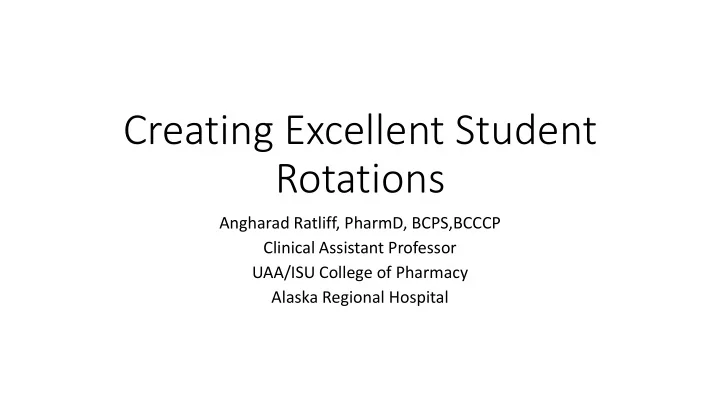

Creating Excellent Student Rotations Angharad Ratliff, PharmD, BCPS,BCCCP Clinical Assistant Professor UAA/ISU College of Pharmacy Alaska Regional Hospital
Objectives • Appropriately categorize learning activities for IPPE rotations • Deliver excellent feedback that encourages student growth • Create an individualized student rotation based on the knowledge of student learning styles
Overview • What is an IPPE? What should be included in the rotation? • Different learning activities based upon rotation type and student progression • Discuss different learning styles • Apply learning styles to appropriate feedback • Identify appropriate activities based upon different learning styles • Student cases
Teaching vs. Parenting • Ten tips for effective teaching, Family Medicine 1998 • Stages of parenting -> stages of teaching
Cognitive Learning • Knowledge – remembering new facts • Comprehension – understanding the meaning of new information • Application – applying knowledge to solve a problem • Analysis – breaking down complex ideas into simpler parts and relationship between the parts • Synthesis – creating something new to solve a complex problem • Evaluation – judging the soundness of one’s own work and that of peers
IPPE – Introductory Pharmacy Practice • Participate in accurate prescription/medication order processing • Demonstrate knowledge of a unit dose system • Demonstrate knowledge of an intravenous admixture system • Demonstrate knowledge of current standards of institutional pharmacy practice • Display appropriate professional behavior and work ethic • Demonstrate cultural and social competency
Example Schedule for Rotations
Table Discussions – • What activities could you do at your site and what level of cognitive learning would that address? • Participate in accurate prescription/medication order processing • Demonstrate knowledge of a unit dose system • Demonstrate knowledge of an intravenous admixture system • Demonstrate knowledge of current standards of institutional pharmacy practice • Display appropriate professional behavior and work ethic • Demonstrate cultural and social competency
Learning Styles ACTING ACCOMODATOR DIVERGER DOING OBSERVING ASSIMILATOR CONVERGER REFLECTING
Accommodator • Approach to material : emphasize utility • Process of learning : action or activity with a reason • Teaching approaches : values outcome • Psycho-educational needs : reason to care and be involved • Relating to Others : values efficiency, ? At the expense of efficacy • Teaching Methods : • Time/resource efficient learning • Practical problem solving • “Just -in- time” curriculum
Diverger • Approach to material : emphasize inter-relationships and connections • Process of learning : reflection-in-action • Teaching approaches : values relationships • Psycho-educational needs : supportive peers, time to reflect and discuss before performing • Relating to Others : values harmony, group process over outcomes • Teaching Methods : • Reflection • Mentoring • Creative, unstructured activities
Assimilator • Approach to material : emphasize theory and expertise • Process of learning : reflection-on-action • Teaching approaches : values credentials • Psycho-educational needs : expert teachers, time to reflect and discuss before performing • Relating to Others : may confuse others’ confidence with competence • Teaching Methods: • Expert-drive lectures • Individual activities • Web-based, non-interactive
Converger • Approach to material : emphasize application and value • Process of learning : action/activity • Teaching approaches : values drive • Psycho-educational needs : an audience to impress with an outcome to achieve • Relating to Others : may mistake own confidence with competence • Teaching Methods : • Purpose-drive group work • Competitions • Role-playing • In-practice activities
Millennial Learners • How to engage millennial learners: • Multimedia – multi-tasking • Be more relaxed • Make your teaching relevant • New teaching methods
Now for the INTERACTIVE Portion…
References • Novotney A. Engaging the millennial learner. American Psychological Association. 2010;41(3):60. • Austin Z. Development and validation of the pharmacists’ inventory of learning styles (PILS). AJPE 2004;68(2) Art 37. • Austin Z. Learning styles of pharmacists: impact on career decisions, practice patterns and teaching method preferences. Pharm Educ 2004;4(10):13-22. • Weitzel KW, Walters EA, Taylor J. Teaching clinical problem solving: a preceptor’s guide. Am J Health -Syst Pharm. 20112;69(15): 1588-99.
ACPE – Appendix 2 Expectations within APPE Curriculum • “Involved interaction with practitioners and patients to advance patient welfare in authentic practice settings, and provides exposure to both medication distribution systems and high-quality, interprofessional, team- based patient care”
Recommend
More recommend